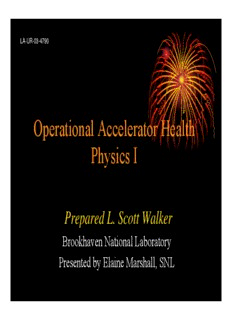
Operational Accelerator Health Physics I PDF
Preview Operational Accelerator Health Physics I
LA-UR-03-4790 Operational Accelerator Health Physics I Prepared L. Scott Walker Brookhaven National Laboratory Presented by Elaine Marshall, SNL Knowledge Base Requirements • Do I need to know how an accelerator operates? No • Should know a wide range of nuclides (particularly neutron deficient radionuclides). • Each radionuclide is treated differently. • Research accelerators produce and experiment with a very wide range of radionuclides. Accelerator Description • Accelerators “Accelerate” fundamental charged particles. • Energy Range: 60 KeV to many TeV. • Accelerator currents: nano-amps to milli-amps. • Accelerator sizes: small “boxes” to hundreds of acres. Accelerated Particles • Protons and Electrons • Anti Protons and Electrons • Heavy Ions • Short Lived Radioisotopes • Charged Sub Particles Particle Definitions • Hadrons Charge Symbol Mass Mean (MeV) λ (s) • Proton + p 938 stable • Neutron 0 n 940 900 • Pion ± π± 140 2.6x10-8 • Pion 0 π0 135 8.4x10-17 • Leptons • Muon ± μ± 106 2.2x10-6 • Electron - e- 0.511 stable • Positron + e+ 0.511 stable Uses • Isotope Production • Neutron Sources • X-Rays, Synchrotron Radiation Production • Research Experiments (Nuclear and Material Science) • Potentially Used for Isotope Destruction • Ion Implantation • Fundamental Research Uses …continued • Electronic Chip Etching? • Medical Treatments • Sterilization (Food and Equipment) • Photon Radiography • Free Electron Lasers • Neutron and Proton Radiography • Weapons and Weapon Interrogation Accelerator Types • Cyclotrons • Synchrotrons • Betatrons • Synchocyclotrons • Van de Graaffs • Cockcroft-Walton • Linear accelerators (Standing and traveling wave) Accelerator Systems • Accelerators operate as single units (or as in the case of large research accelerators) several different accelerators joined together. • Typical large research accelerators utilize a D.C. injector, connected to a drift tube linear accelerator which is in turn connected to a synchrotron or side coupled linear accelerator. Accelerator Systems Described in This Class • Each research accelerator: Distinct design and operational characteristics. • Similar particles may be accelerated but each accelerator is designed for a slightly different use. • Since each accelerator is designed differently, accelerator health physics programs and concerns are each slightly different. • ~30,000 accelerators around the world.
Description: